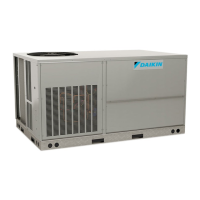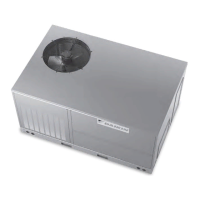SERVICING
29
S-18A CHECKING CRANKCASE HEATER THER-
MOSTAT
Note: Not all models with crankcase heaters will have a
crankcase heater thermostat.
1. Install a thermocouple type temperature test lead on the
discharge line adjacent to the crankcase heater thermo-
stat.
2. Check the temperature at which the control closes its
contacts by lowering the temperature of the control. The
crankcase heater thermostat should close at 67°F ± 5°F.
3. Check the temperature at which the control opens its
contacts by raising the temperature of the control. The
crankcase heater thermostat should open at 85°F ± 5°F.
4. If not as above, replace control.
S-21 CHECKING REVERSING VALVE AND SOLE-
NOID
Occasionally the reversing valve may stick in the heating or
cooling position or in the mid-position.
When stuck in the mid-position, part of the discharge gas
from the compressor is directed back to the suction side,
resulting in excessively high suction pressure. An increase
in the suction line temperature through the reversing valve
can also be measured. Check operation of the valve by
starting the system and switching the operation from COOL-
ING to HEATING cycle.
If the valve fails to change its position, test the voltage (24V)
at the valve coil terminals, while the system is on the COOLING
cycle.
If no voltage is registered at the coil terminals, check the
operation of the thermostat and the continuity of the connect-
ing wiring from the "O" terminal of the thermostat to the unit.
If voltage is registered at the coil, tap the valve body lightly
while switching the system from HEATING to COOLING, etc.
If this fails to cause the valve to switch positions, remove the
coil connector cap and test the continuity of the reversing
valve solenoid coil. If the coil does not test continuous -
replace it.
If the coil test continuous and 24 volts is present at the coil
terminals, the valve is inoperative - replace it.
S-24 TESTING DEFROST CONTROL
To check the defrost control for proper sequencing, proceed
as follows: With power ON; unit not running.
1. Jumper defrost thermostat by placing a jumper wire
across the terminals "DFT" and "R" at defrost control
board.
2. Connect jumper across test pins on defrost control board.
3. Set thermostat to call for heating. System should go into
defrost within 21 seconds.
4. Immediately remove jumper from test pins.
5. Using VOM check for voltage across terminals "C & O".
Meter should read 24 volts.
6. Using VOM check for voltage across fan terminals DF1
and DF2 on the board. You should read line voltage (208-
230 VAC) indicating the relay is open in the defrost mode.
7. Using VOM check for voltage across "W2 & C" terminals
on the board. You should read 24 volts.
8. If not as above, replace control board.
9. Set thermostat to off position and disconnect power
before removing any jumpers or wires.
NOTE: Remove jumper across defrost thermostat before
returning system to service.
S-25 TESTING DEFROST THERMOSTAT
1. Install a thermocouple type temperature test lead on the
tube adjacent to the defrost control. Insulate the lead
point of contact.
2. Check the temperature at which the control closes its
contacts by lowering the temperature of the control. On
2 and 2.5 ton units, it should close at 34°F ± 5°F. On 3 thru
5 ton units, it should close at 31°F ± 3°F.
3. Check the temperature at which the control opens its
contacts by raising the temperature of the control. On 2
and 2.5 ton units, it should open at 60°F ± 5°F. On 3 thru
5 ton units, it should open at 75°F ± 6°F.
4. If not as above, replace control.
TROUBLESHOOTING
THE FOLLOWING INFORMATION IS FOR USE BY QUALI-
FIED SERVICE AGENCY ONLY: OTHERS SHOULD NOT
ATTEMPT TO SERVICE THIS EQUIPMENT.
Common Causes of Unsatisfactory Operation of Heat Pump
on the Heating Cycle.
INADEQUATE AIR VOLUME THROUGH INDOOR COIL
When a heat pump is in the heating cycle, the indoor coil is
functioning as a condenser. The return air filter must always
be clean, and sufficient air volume must pass through the
indoor coil to prevent excessive discharge pressure, and high
pressure cut out.
OUTSIDE AIR INTO RETURN DUCT
Do not introduce cold outside air into the return duct of a heat
pump installation. For units with 2-speed motors, do not
allow air entering the indoor coil to drop below 65° F. Air below
this temperature will cause low discharge pressure, thus low
suction pressure, and excessive defrost cycling resulting in
low heating output. It may also cause false defrosting.

